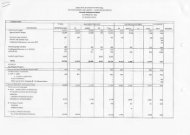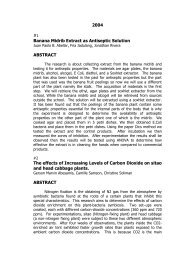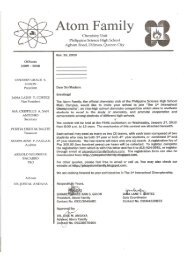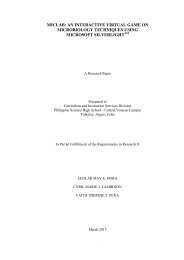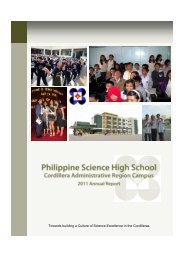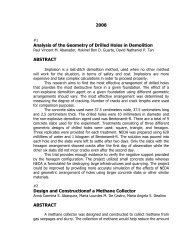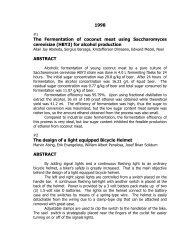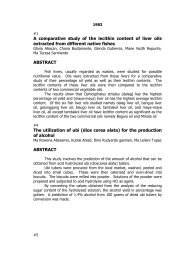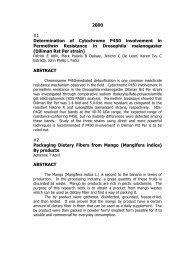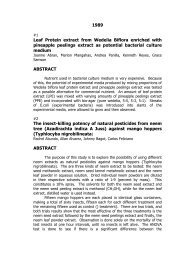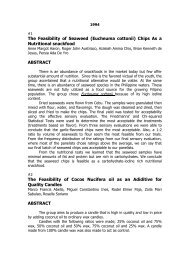A comparative study of paper produced from zea mays - Philippine ...
A comparative study of paper produced from zea mays - Philippine ...
A comparative study of paper produced from zea mays - Philippine ...
Create successful ePaper yourself
Turn your PDF publications into a flip-book with our unique Google optimized e-Paper software.
different nutritive components <strong>of</strong> the samples. Sample 1 had the following<br />
composition: .36% Nitrogen, .28% Phosphorus, .38% Potassium, 8.65%<br />
moisture. For sample 2, the following values were obtained: .33% Nitrogen,<br />
.16% Phosphorus, .39% Potassium, 6.56% moisture. For sample 3, had the<br />
following composition : .30% Nitrogen, .24% Phosphorous, .46% Potassium<br />
and 5.85% moisture. Sample 4 was as follows: .40% Nitrogen, .52%<br />
Phosphorous, .44% Potassium and 6.30% moisture.<br />
The group chose tomato as the experimental plant because <strong>of</strong> its<br />
availability, its relatively short maturation period, and most important, its<br />
need for nutrients such as Nitrogen, phosphorus, and potassium, otherwise<br />
known by their atomic symbols N-P-K.<br />
#3<br />
The phytochemical screening and microbiological assay <strong>of</strong><br />
“Philodendron laceron” (toothed Philodendron)<br />
Joel M Addawe, Marie Patricoa G Casiño, Dorinda S Doroja, Theodore D<br />
Erguiza, Sharon C Lopez<br />
ABSTRACT<br />
This research project is aimed at determining the phytochemical<br />
properties <strong>of</strong> the leaves <strong>of</strong> Philodendron leacerum. The phytochemical<br />
screening which was done on the ethanolic extract <strong>of</strong> the plant’s leaves<br />
showed that alkaloids, quarternary and / or amine oxide bases and<br />
polyphenolic compounds were present.<br />
Using <strong>paper</strong>-disc diffusion method, the ethanolic extracts were tested<br />
for their inhibitory effects against S cerevisiae, Eschrichia coli, Mycobacterium,<br />
Fusarium monoliforme, and Rhizopus arrhizus. The extracts showed no<br />
substantial inhibitory activities against these microorganisms.<br />
#5<br />
Nutritive content <strong>of</strong> Mangifera indica (mangga) leaves<br />
Ma Emilita Marcia Aguilar, Jennifer Emilie Gache, Frederick Ulpiano Pontillas,<br />
Anna Lourdes San Luis<br />
ABSTRACT<br />
Mango leaves are known to be used by barrio folk in dishes such as<br />
kilawin, sinigang and pinangat. This <strong>study</strong> has determined the basic nutritive<br />
constituents <strong>of</strong> mango leaves using proximate analysis. The mature leaves<br />
were found to contain nutrient in the following amounts: crude fat, 5.32%;<br />
crude fiber, 7.866%; moisture, 58.1265%; ash 6.465%; carbohydrates,<br />
22.2%; protein, only a trace. On the other hand, the young leaves were<br />
found to contain nutrients in the following percentages: crude fat, 2.125%;<br />
crude fiber, 4.43%; moisture, 78.5385%; ash, .17%; carbohydrates,<br />
14.7365%; protein, just a trace, too. The relatively high carbohydrate, fiber<br />
and fat content <strong>of</strong> the leaves make them a feasible feed supplement for



